Potential Output: Concepts and Measurement - Department of Labour
Potential Output: Concepts and Measurement - Department of Labour
Potential Output: Concepts and Measurement - Department of Labour
Create successful ePaper yourself
Turn your PDF publications into a flip-book with our unique Google optimized e-Paper software.
Darren Gibbs 83<br />
p<br />
⎛ Qt<br />
Assuming that labour productivity ⎜ ⎞<br />
p<br />
⎟<br />
⎝ Lt<br />
⎠ follows a simple time pattern,<br />
Christiano rearranges the above equation to express actual labour input as a<br />
function <strong>of</strong> actual output <strong>and</strong> that time pattern, <strong>and</strong> obtains estimates <strong>of</strong> the b s<br />
coefficients. Using these coefficients <strong>and</strong> an independent measure <strong>of</strong> L p t<br />
, 11 the<br />
dem<strong>and</strong> equation can be inverted to yield an estimate <strong>of</strong> the output gap as a<br />
function <strong>of</strong> lagged values <strong>of</strong> the input gap.<br />
A second approach which makes use <strong>of</strong> a capital (or investment) dem<strong>and</strong><br />
function was proposed by Hickman (1964). In this approach the dem<strong>and</strong> for<br />
capital, K * t<br />
, is expressed as:<br />
* * *<br />
t 0 1 t 2 t 3<br />
log K = α + α logQ + α log P + α t<br />
where Q t * <strong>and</strong> P t * represent permanent income <strong>and</strong> relative output prices at time<br />
t. (The model assumes annual data.)<br />
Assuming that the capital stock follows a partial adjustment process, <strong>and</strong> that<br />
both permanent income <strong>and</strong> relative output prices depend linearly on current<br />
<strong>and</strong> lagged values <strong>of</strong> actual output <strong>and</strong> actual prices respectively, it is possible<br />
to estimate Q t * as a function <strong>of</strong> capital <strong>and</strong> output price series.<br />
The relative advantage <strong>of</strong> the inverted dem<strong>and</strong> function approaches discussed<br />
above is that although, computationally, they are slightly more burdensome than<br />
the other approaches discussed so far, they do go some way towards addressing<br />
some <strong>of</strong> the weaknesses in the simpler approaches. They are also simpler to<br />
apply than the next technique we will discuss, which requires us to estimate the<br />
underlying production function. However, as is usually the case, the search for<br />
computational simplicity requires a trade-<strong>of</strong>f to be made with theoretical<br />
desirability. Strong assumptions need to be made about functional forms <strong>and</strong> the<br />
time behaviour <strong>of</strong> various variables.<br />
There are a number <strong>of</strong> difficulties with applying these approaches to New<br />
Zeal<strong>and</strong> data. In the case <strong>of</strong> the labour dem<strong>and</strong> approach, sufficiently disaggregated<br />
data over a long enough time period is either extremely unreliable or<br />
simply unavailable. Without this disaggregation, the approach differs little from<br />
that suggested by Okun; <strong>and</strong> the capital dem<strong>and</strong> approach has all the limitations<br />
that were discussed earlier in the context <strong>of</strong> the output/capital ratio approach.<br />
The production function approach<br />
The final approach that we shall discuss in this section is the production function<br />
approach which, at least on theoretical grounds, is by far the most desirable. The<br />
essence <strong>of</strong> the production function approach is an explicit modelling <strong>of</strong> output<br />
in terms <strong>of</strong> the underlying factor inputs, which involves the specification <strong>and</strong><br />
11<br />
Christiano derives a measure <strong>of</strong> potential hours dem<strong>and</strong> by applying cyclically adjusted<br />
participation <strong>and</strong> unemployment rates to eight age-gender groups in the population.<br />
Hours are converted to efficiency units by valuing them using relative wages. This is <strong>of</strong>ten<br />
known as ‘Perry weighting’, based on Perry (1971).



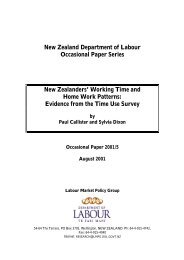

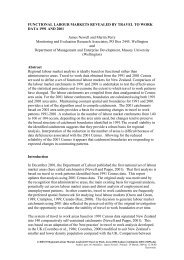

![a note on levels, trends, and some implications [pdf 21 pages, 139KB]](https://img.yumpu.com/27285836/1/184x260/a-note-on-levels-trends-and-some-implications-pdf-21-pages-139kb.jpg?quality=85)


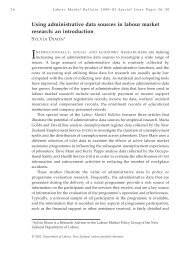
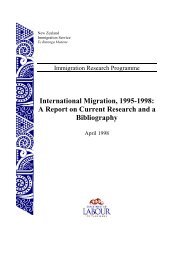

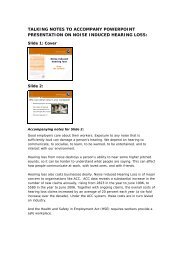
![Labour Market Trends and Outlook - 1996 [pdf 18 pages, 94KB]](https://img.yumpu.com/27285764/1/184x260/labour-market-trends-and-outlook-1996-pdf-18-pages-94kb.jpg?quality=85)

